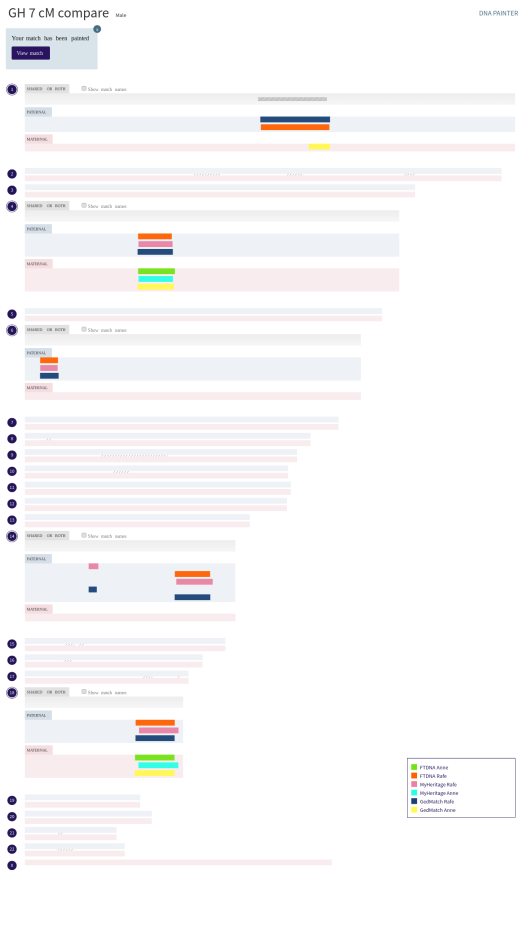Last week I met one of my cousins, N., for the first time. He is interested in family history and, among other things, we talked about autosomal DNA testing.
A genealogical DNA test examines the nucleotides – the building blocks of DNA and RNA – at specific locations on a person’s DNA.
An autosomal DNA test looks at the 22 pairs of chromosomes that are not sex chromosomes (the X chromosome and the Y chromosome are sex chromosomes). These 22 chromosomes are known as autosomes. Autosomal DNA tests can be used to find cousins, and this often helps geneological research.
N.’s brother has already taken a test with AncestryDNA. We talked about whether it would it be better to take a test with another company and how much DNA might he and his brother share.
My recommendation is to test at AncestryDNA. N. and his brother will share close cousin matches but will also share different matches with more distant cousins.
AncestryDNA has by far the largest number of users. In May 2019 it had 15 million kits in its database.
The second largest database is 23andMe, with more than 10 million people in April 2019. It is an expensive test for Australians, however, as shipping costs are $40 US per kit. As a result there are fewer Australian participants. I have not tested with 23andMe.
FamilyTreeDNA (FTDNA) is one of the smaller databases. It is estimated to have about 1 million kits in its database. It is not marketed as aggressively as the other companies. However, with FTDNA, you can test not only autosomal DNA but also Y-DNA and maternal DNA, and so you are able to trace your direct paternal line and your direct maternal line further generations back. You can also transfer your DNA data from other
testing companies to join the database.
MyHeritage is a newer testing service. It allows people to transfer their DNA data into the MyHeritage database. In May 2019 it had about 3 million kits in May 2019.
Another service is GEDMatch. It is not a testing site but you can transfer your DNA data there and compare data and find matches with people who have tested at other companies. In May 2019 GEDMatch had about 1.2 million participants.
AncestryDNA does not allow users to transfer data into its database. To participate you have to test at its site.
Given this variety of testing and analysis services, I recommend testing at AncestryDNA and uploading your DNA data to FTDNA, MyHeritage and GEDMatch. A small fee at each of these separate sites can unlock some more advanced analysis tools.
If N. is interested in pursuing his paternal and maternal genealogy he would probably also be interested in testing at FamilyTreeDNA and taking their two additional tests for Y-DNA and Mitochondrial DNA.
Your siblings have inherited part of your parents’ DNA that you don’t carry. There is some overlap with your DNA. You would expect siblings to share about 50% of their DNA. In fact there is some variation. Siblings have been found to share 2209 to 3384 centimorgans of 6800 possible centimorgans, from 33% to just under 50%.

Schematic representation of the transmission of the autosomes of the grandparents to three siblings. Retrieved from Wikimedia Commons, diagram created by Jordi picart – Own work, licensed CC BY-SA 4.0
It has been estimated that up to 10% of third cousins and up to 50% of 4th cousins will not share enough DNA to show up as match. (Third cousins share great great grandparents and 4th cousins share 3rd great grandparents.)
Having your siblings’ DNA analysed will increase your chances of finding cousin matches. This will probably help you to make progress with your family history.
Sources
- International Society of Genetic Genealogy Wiki
- Larkin, Leah. “Genealogical Database Growth Slows.” The DNA Geek, Leah Larkin, 22 June 2019, thednageek.com/genealogical-database-growth-slows/.
- Bettinger, Blaine. “August 2017 Update to the Shared CM Project.” The Genetic Genealogist, Blaine Bettinger, 26 Aug. 2017, thegeneticgenealogist.com/2017/08/26/august-2017-update-to-the-shared-cm-project/.
- DNA Painter: The Shared cM Project 3.0 tool v4


